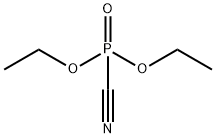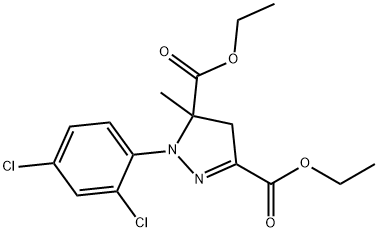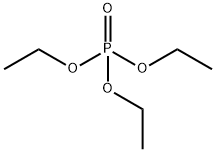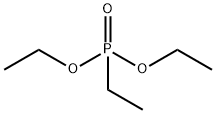Diethyl cyanophosphonate
Synonym(s):DEPC;Diethyl phosphoryl cyanide
- CAS NO.:2942-58-7
- Empirical Formula: C5H10NO3P
- Molecular Weight: 163.11
- MDL number: MFCD00010256
- EINECS: 220-936-5
- SAFETY DATA SHEET (SDS)
- Update Date: 2025-09-25 17:15:13

What is Diethyl cyanophosphonate?
Chemical properties
Diethyl cyanophosphonate is a clear colourless to yellow liquid. It soluble in most common organic solvents , such as dimethylformamide , tetrahydrofuran , diethyl ether , and toluene. Diethyl cyanophosphonate is highly toxic and corrosive. lt must be handled in awell-ventilated fume hood. In addition, it is moisture sensitive and should bestored in a refrigerator under nitrogen.
The Uses of Diethyl cyanophosphonate
Diethyl cyanophosphonate was used in the synthesis of 4-acylthiol-4-deoxy-4′-demethyl epipodophyllotoxin analogs. Coupling reagent for peptide synthesis. Reagent for the phosphorylation of phenols. Activating agent for fluorescent derivatization of carboxylic acids which allows separation by HPLC.
What are the applications of Application
1973 Harusawa et al. found that diethyl phosphorocyanidate (diethyl cyanophosphonate; depc), a cyano and diethyl analog of DPPA, was a valuable reagent for peptide synthesis. DEPC is a practical and versatile reagent for organic synthesis, particularly as a condensing reagent for the synthesis of amides and peptides and its application in O-, S-, and C-acylations. Compared to other cyanating agents, DEPC is significantly less toxic and commercially available. DEPC can also be employed as a cyanating agent for introducing a C1 unit into a range of compounds, and its reaction with carbonyl compounds in the presence of a catalyst easily affords CPs, which are key intermediates in a variety of reactions[1].
General Description
Diethyl cyanophosphonate (DCNP, a Tabun mimic, DECP) is a nerve agent simulant. Its detection by using fluorescein, a reversible fluorescent sensor, has been reported. Its degradation in the presence of suitable organocatalysts (different amines, aminoalcohols and glycols) has been studied.
References
[1] Shinya Harusawa , Takayuki Shioiri. “Diethyl phosphorocyanidate (DEPC): a versatile reagent for organic synthesis.” Tetrahedron 72 50 (2016): Pages 8125-8200.
Properties of Diethyl cyanophosphonate
| Boiling point: | 104-105 °C19 mm Hg(lit.) |
| Density | 1.075 g/mL at 25 °C(lit.) |
| refractive index | n |
| Flash point: | 177 °F |
| storage temp. | 2-8°C |
| solubility | Acetonitrile (Slightly), Chloroform (Slightly) |
| form | Liquid |
| color | Clear colorless to yellow |
| Specific Gravity | 1.075 |
| Water Solubility | DECOMPOSES |
| Sensitive | Moisture Sensitive |
| BRN | 1768938 |
| Exposure limits | NIOSH: IDLH 25 mg/m3 |
| Stability: | Moisture Sensitive |
| CAS DataBase Reference | 2942-58-7(CAS DataBase Reference) |
| NIST Chemistry Reference | Diethyl cyanophosphonate(2942-58-7) |
Safety information for Diethyl cyanophosphonate
| Signal word | Danger |
| Pictogram(s) |
 Corrosion Corrosives GHS05  Skull and Crossbones Acute Toxicity GHS06 |
| GHS Hazard Statements |
H314:Skin corrosion/irritation |
| Precautionary Statement Codes |
P280:Wear protective gloves/protective clothing/eye protection/face protection. P301+P330+P331:IF SWALLOWED: Rinse mouth. Do NOT induce vomiting. P303+P361+P353:IF ON SKIN (or hair): Remove/Take off Immediately all contaminated clothing. Rinse SKIN with water/shower. P305+P351+P338:IF IN EYES: Rinse cautiously with water for several minutes. Remove contact lenses, if present and easy to do. Continuerinsing. |
Computed Descriptors for Diethyl cyanophosphonate
New Products
4,4-Difluoropiperidine hydrochloride tert-butyl 9-methoxy-3-azaspiro[5.5]undecane-3-carboxylate Indole Methyl Resin N-Isopropylurea N,N-Dicyclohexylcarbodiimide(DCC) MELDRUMS ACID 5-METHYLISOXAZOLE-4-CARBOXYLIC ACID Magnessium Bis glycinate Zinc ascorbate 1-bromo-2-butyne 2-acetamidophenol 9(10H)-anthracenone Erythrosin B, 4-Piperidinopiperidine 2-((4-morpholinophenylamino) (methylthio) methylene) malononitrile 2,4-dihydroxybenzaldehyde 3-(4-morpholinophenylamino)-5-amino-1H-pyrazole-4-carbonitrile Methyl 2-methylquinoline-6-carboxylate 2,6-dichloro-4-nitropyridine 4-Bromo-2-chlorobenzonitrile 2-(benzylamino)acetic acid hydrochloride 4-(tert-Butoxycarbonylamino)but- 2-ynoic acid 3,4-dihydro-2H-benzo[b][1,4]dioxepine 1-Phenyl-1-cycloprppanecarboxylicacidRelated products of tetrahydrofuran








You may like
-
 Diethyl Cyanophosphonate CAS 2942-58-7View Details
Diethyl Cyanophosphonate CAS 2942-58-7View Details
2942-58-7 -
 3-(4-amino-1-oxoisoindolin-2-yl)-1-methylpiperidine-2,6-dione 98%View Details
3-(4-amino-1-oxoisoindolin-2-yl)-1-methylpiperidine-2,6-dione 98%View Details -
 614-19-7 98%View Details
614-19-7 98%View Details
614-19-7 -
 3112-85-4 Methyl phenyl sulfone 98%View Details
3112-85-4 Methyl phenyl sulfone 98%View Details
3112-85-4 -
 20677-73-0 (2,2-diethoxyethyl)methylamine 98%View Details
20677-73-0 (2,2-diethoxyethyl)methylamine 98%View Details
20677-73-0 -
 3-(4-(hydroxyamino)-1-oxoisoindolin-2-yl)piperidine-2,6-dione 98%View Details
3-(4-(hydroxyamino)-1-oxoisoindolin-2-yl)piperidine-2,6-dione 98%View Details -
 57381-49-4 2-bromo-4-chlorobenzonitrile 98%View Details
57381-49-4 2-bromo-4-chlorobenzonitrile 98%View Details
57381-49-4 -
 4,6-dichloropyrimidine-5-carbaldehyde 98%View Details
4,6-dichloropyrimidine-5-carbaldehyde 98%View Details
5305-40-8
